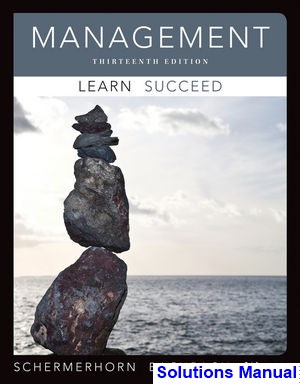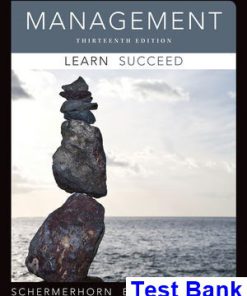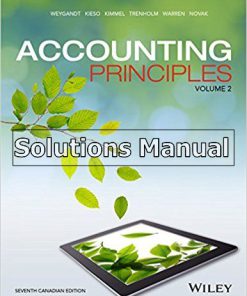Management 13th Edition Schermerhorn Solutions Manual
You may also like
-
$26.50
$50.00 -
$26.50
$50.00
Management 13th Edition Schermerhorn Solutions Manual

Product details:
- ISBN-10 : 1118841514
- ISBN-13 : 978-1118841518
- Author: Dr. John R. Schermerhorn, Jr.
We’ve got you covered for your Principles of Management course with Schermerhorn/Bachrach, Management 13th Edition Binder Ready Version. With new cases, more opportunities for self-assessment and the Management Weekly Updates news blog, the text and its comprehensive suite of resources promote critical thinking and active learning. Thoroughly updated while maintaining its trusted balance of concepts and applications, Management 13th Edition Binder Ready Version presents the most current material to apply theory and show relevance of management concepts in the real world–for students to succeed in your management course and beyond. This text is an unbound, binder-ready version.
Table contents:
- 1 Management Today
- Working Today
- Talent
- Technology
- Globalization
- Ethics
- Diversity
- Careers and Connections
- Organizations
- Organizational Purpose
- Organizations as Systems
- Organizational Performance
- Changing Nature of Organizations
- Managers
- What Is a Manager?
- Levels of Managers
- Types of Managers
- Managerial Performance
- Changing Nature of Managerial Work
- The Management Process
- Functions of Management
- Managerial Roles and Activities
- Managerial Agendas and Networks
- Learning How to Manage
- Technical Skills
- Human and Interpersonal Skills
- Conceptual and Critical-Thinking Skills
- Management Learning Review
- Summary
- Self-Test 1
- Management Skills & Competencies
- Evaluate Career Situations: What Would You Do?
- Reflect on the Self-Assessment: Career Readiness “Big 20”
- Contribute to the Class Exercise: My Best Manager
- Manage a Critical Incident: Team Leader Faces Test
- Collaborate on the Team Activity: The Amazing Great Job Race
- Analyze the Case Study: Trader Joe’s
- 2 Management Learning Past to Present
- Classical Management Approaches
- Scientific Management
- Administrative Principles
- Bureaucratic Organization
- Behavioral Management Approaches
- Follett’s Organizations as Communities
- The Hawthorne Studies
- Maslow’s Theory of Human Needs
- McGregor’s Theory X and Theory Y
- Argyris’s Theory of Adult Personality
- Modern Management Foundations
- Quantitative Analysis and Tools
- Organizations as Systems
- Contingency Thinking
- Quality Management
- Evidence-Based Management
- Management Learning Review
- Summary
- Self-Test 2
- Management Skills & Competencies
- Evaluate Career Situations: What Would You Do?
- Reflect on the Self-Assessment: Managerial Assumptions
- Contribute to the Class Exercise: Evidence-Based Management Quiz
- Manage a Critical Incident: Theory X versus Theory Y
- Collaborate on the Team Activity: Management in Popular Culture
- Analyze the Case Study: Zara International
- 3 Ethics and Social Responsibility
- Ethics
- Laws and Values as Influences on Ethical Behavior
- Alternative Views of Ethics
- Cultural Issues in Ethical Behavior
- Ethics in the Workplace
- Ethical Dilemmas
- Influences on Ethical Decision Making
- Rationalizations for Unethical Behavior
- Maintaining High Ethical Standards
- Moral Management
- Ethics Training
- Codes of Ethical Conduct
- Whistleblower Protection
- Social Responsibility
- Social Responsibility, Sustainability, and the Triple Bottom Line
- Perspectives on Corporate Social Responsibility
- Evaluating Corporate Social Performance
- Corporate Governance
- Management Learning Review
- Summary
- Self-Test 3
- Management Skills & Competencies
- Evaluate Career Situations: What Would You Do?
- Reflect on the Self-Assessment: Terminal Values
- Contribute to the Class Exercise: Confronting Ethical Dilemmas
- Manage a Critical Incident: Dealing with a Global Supply Chain
- Collaborate on the Team Activity: Stakeholder Maps
- Analyze the Case Study: Patagonia
- Part Two Environment
- 4 Environment, Innovation, and Sustainability
- The External Environment
- Economic Conditions
- Legal-Political Conditions
- Sociocultural Conditions
- Technological Conditions
- Natural Environment Conditions
- Environment and Value Creation
- Value Creation and Competitive Advantage
- Uncertainty, Complexity, and Change
- Environment and Innovation
- Types of Innovations
- The Innovation Process
- Disruptive Innovation and Technology
- Environment and Sustainability
- Sustainable Development
- Sustainable Business
- Human Sustainability
- Management Learning Review
- Summary
- Self-Test 4
- Management Skills & Competencies
- Evaluate Career Situations: What Would You Do?
- Reflect on the Self-Assessment: Tolerance for Ambiguity
- Contribute to the Class Exercise: The Future Workplace
- Manage a Critical Incident: It’s Also about Respect
- Collaborate on the Team Activity: Organizational Commitment to Sustainability Scorecard
- Analyze the Case Study: Timberland
- 5 Global Management and Cultural Diversity
- Management and Globalization
- Global Management
- Why Companies Go Global
- How Companies Go Global
- Global Business Environments
- Global Businesses
- Types of Global Businesses
- Pros and Cons of Global Businesses
- Ethics Challenges for Global Businesses
- Cultures and Global Diversity
- Cultural Intelligence
- Silent Languages of Culture
- Tight and Loose Cultures
- Values and National Cultures
- Global Management Learning
- Are Management Theories Universal?
- Intercultural Competencies
- Global Learning Goals
- Management Learning Review
- Summary
- Self-Test 5
- Management Skills & Competencies
- Evaluate Career Situations: What Would You Do?
- Reflect on the Self-Assessment: Global Intelligence
- Contribute to the Class Exercise: American Football
- Manage a Critical Incident: Silent Team Members
- Collaborate on the Team Activity: Globalization Pros and Cons
- Analyze the Case Study: Harley-Davidson
- 6 Entrepreneurship and New Ventures
- The Nature of Entrepreneurship
- Who Are the Entrepreneurs?
- Characteristics of Entrepreneurs
- Female and Minority Entrepreneurs
- Social Entrepreneurship
- Entrepreneurship and Small Business
- How Small Businesses Get Started
- Why Small Businesses Fail
- Family-Owned Small Businesses
- Small Business Development
- New Venture Creation
- Life Cycles of Entrepreneurial Firms
- Writing a Business Plan
- Choosing a Form of Ownership
- Financing a New Venture
- Management Learning Review
- Summary
- Self-Test 6
- Management Skills & Competencies
- Evaluate Career Situations: What Would You Do?
- Reflect on the Self-Assessment: Entrepreneurial Orientation
- Contribute to the Class Exercise: Entrepreneurs Among Us
- Manage a Critical Incident: Craft Brewery in-or Out-of the Money?
- Collaborate on the Team Activity: Community Entrepreneurs
- Analyze the Case Study: In-N-Out Burger
- Part Three Planning and Controlling
- 7 Information and Decision Making
- Information, Technology, and Management
- Information and Information Systems
- Data Mining and Analytics
- Business Intelligence and Executive Dashboards
- Problem-Solving and Managerial Decisions
- Managers as Problem Solvers
- Problem-Solving Approaches and Styles
- Structured and Unstructured Problems
- Crisis Problems
- Problem-Solving Environments
- The Decision-Making Process
- Step 1-Identify and Define the Problem
- Step 2-Generate and Evaluate Alternative Courses of Action
- Step 3-Choose a Preferred Course of Action
- Step 4-Implement the Decision
- Step 5-Evaluate Results
- At All Steps-Check Ethical Reasoning
- Decision-Making Pitfalls and Creativity
- Decision Errors and Traps
- Creativity in Decision Making
- Management Learning Review
- Summary
- Self-Test 7
- Management Skills & Competencies
- Evaluate Career Situations: What Would You Do?
- Reflect on the Self-Assessment: Cognitive Style
- Contribute to the Team Exercise: Lost at Sea
- Manage a Critical Incident: Asking for a Raise
- Collaborate on the Team Project: Crisis Management Realities
- Analyze the Case Study: Amazon.com
- 8 Planning Processes and Techniques
- Why and How Managers Plan
- Importance of Planning
- The Planning Process
- Benefits of Planning
- Planning and Time Management
- Types of Plans Used by Managers
- Long-Range and Short-Range Plans
- Strategic and Tactical Plans
- Operational Plans
- Planning Tools and Techniques
- Forecasting
- Contingency Planning
- Scenario Planning
- Benchmarking
- Staff Planning
- Implementing Plans to Achieve Results
- Goal Setting
- Goal Management
- Goal Alignment
- Participation and Involvement
- Management Learning Review
- Summary
- Self-Test 8
- Management Skills & Competencies
- Evaluate Career Situations: What Would You Do?
- Reflect on the Self-Assessment: Time Management Profile
- Contribute to the Team Exercise: Personal Career Planning
- Manage a Critical Incident: Policy on Paternity Leave for New Dads
- Collaborate on a Team Activity: The Future Workplace
- Analyze the Case Study: Walgreens
- 9 Control Processes and Systems
- Why and How Managers Control
- Importance of Controlling
- Types of Controls
- Internal and External Control
- The Control Process
- Step 1-Establish Objectives and Standards
- Step 2-Measure Actual Performance
- Step 3-Compare Results with Objectives and Standards
- Step 4-Take Corrective Action
- Control Tools and Techniques
- Project Management and Control
- Inventory Control
- Breakeven Analysis
- Financial Controls
- Balanced Scorecards
- Management Learning Review
- Summary
- Self-Test 9
- Management Skills & Competencies
- Evaluate Career Situations: What Would You Do?
- Reflect on the Self-Assessment: Internal/External Control
- Contribute to the Class Exercise: After-Meeting/Project Remorse
- Manage a Critical Incident: High Performer but Late for Work
- Collaborate on the Team Activity: Building a Balanced Scorecard
- Analyze the Case Study: Electronic Arts
- 10 Strategy and Strategic Management
- Strategic Management
- Competitive Advantage
- Strategy and Strategic Intent
- Levels of Strategy
- Strategic Management Process
- Essentials of Strategic Analysis
- Analysis of Mission, Values, and Objectives
- SWOT Analysis of Organization and Environment
- Five Forces Analysis of Industry Attractiveness
- Corporate-Level Strategy Formulation
- Portfolio Planning Model
- Growth and Diversification Strategies
- Retrenchment and Restructuring Strategies
- Global Strategies
- Cooperative Strategies
- Business-Level Strategy Formulation
- Competitive Strategies Model
- Differentiation Strategy
- Cost Leadership Strategy
- Focus Strategy
- Strategy Implementation
- Management Practices and Systems
- Strategic Control and Corporate Governance
- Strategic Leadership
- Management Learning Review
- Summary
- Self-Test 10
- Management Skills & Competencies
- Evaluate Career Situations: What Would You Do?
- Reflect on the Self-Assessment: Intuitive Ability
- Contribute to the Class Exercise: Strategic Scenarios
- Manage a Critical Incident: Kickstarting a Friend’s Business Idea
- Collaborate on the Team Activity: Contrasting Strategies
- Analyze the Case Study: Dunkin’ Donuts
- Part Four Organizing
- 11 Organization Structures and Design
- Organizing as a Management Function
- What Is Organization Structure?
- Formal Structures
- Informal Structures and Social Networks
- Traditional Organization Structures
- Functional Structures
- Divisional Structures
- Matrix Structures
- Horizontal Organization Structures
- Team Structures
- Network Structures
- Boundaryless Structures
- Organizational Designs
- Contingency in Organizational Design
- Mechanistic and Organic Designs
- Trends in Organizational Designs
- Management Learning Review
- Summary
- Self-Test 11
- Management Skills & Competencies
- Evaluate Career Situations: What Would You Do?
- Reflect on the Self-Assessment: Empowering Others
- Contribute to the Class Exercise: Organizational Metaphors
- Manage a Critical Incident: Crowdsourcing Evaluations to Cut Management Levels
- Collaborate on the Team Activity: Designing a Network University
- Analyze the Case Study: Nike
- 12 Organization Culture and Change
- Organizational Cultures
- Understanding Organizational Cultures
- Observable Culture of Organizations
- Values and the Core Culture of Organizations
- Multicultural Organizations and Diversity
- Multicultural Organizations
- Organizational Subcultures
- Power, Diversity, and Organizational Subcultures
- Organizational Change
- Models of Change Leadership
- Transformational and Incremental Change
- Phases of Planned Change
- Change Strategies
- Resistance to Change
- Management Learning Review
- Summary
- Self-Test 12
- Management Skills & Competencies
- Evaluate Career Situations: What Would You Do?
- Reflect on the Self-Assessment: Change Leadership IQ
- Contribute to the Class Exercise: Force-Field Analysis
- Manage a Critical Incident: Proposal for Open Office Design and Hotdesking
- Collaborate on the Team Activity: Organizational Culture Walk
- Analyze the Case Study: Gamification
- 13 Human Resource Management
- Human Resource Management
- Human Resource Management Process
- Strategic Human Resource Management
- Legal Environment of Human Resource Management
- Attracting a Quality Workforce
- Human Resource Planning
- Recruitment Process
- Selection Techniques
- Developing a Quality Workforce
- Onboarding and Socialization
- Training and Development
- Performance Management
- Maintaining a Quality Workforce
- Flexibility and Work–Life Balance
- Compensation and Benefits
- Retention and Turnover
- Labor–Management Relations
- Management Learning Review
- Summary
- Self-Test 13
- Management Skills & Competencies
- Evaluate Career Situations: What Would You Do?
- Reflect on the Self-Assessment: Performance Assessment Assumptions
- Contribute to the Class Exercise: Upward Appraisal
- Manage a Critical Incident: Athletic Director’s Dilemma
- Collaborate on the Team Activity: Future of Labor Unions
- Analyze the Case Study: Two-Tier Wages
- Part Five Leading
- 14 Leading and Leadership Development
- The Nature of Leadership
- Leadership and Power
- Leadership and Vision
- Leadership and Service
- Leadership and Followership
- Leadership Traits and Behaviors
- Leadership Traits
- Leadership Behaviors
- Classic Leadership Styles
- Contingency Approaches to Leadership
- Fiedler’s Contingency Model
- Hersey-Blanchard Situational Leadership Model
- House’s Path–Goal Leadership Theory
- Leader–Member Exchange Theory
- Leader-Participation Model
- Personal Leadership Development
- Charismatic and Transformational Leadership
- Emotional Intelligence and Leadership
- Gender and Leadership
- Moral Leadership
- Drucker’s “Good Old-Fashioned” Leadership
- Management Learning Review
- Summary
- Self-Test 14
- Management Skills & Competencies
- Evaluate Career Situations: What Would You Do?
- Reflect on the Self-Assessment: Least-Preferred Co-Worker Scale
- Contribute to the Class Exercise: Most Needed Leadership Skills
- Manage a Critical Incident: Playing Favorites as a Team Leader
- Collaborate on the Team Activity: Leadership Believe-It-or-Not
- Analyze the Case Study: Zappos
- 15 Individual Behavior
- Perception
- Perception and Psychological Contracts
- Perception and Attribution
- Perception Tendencies and Distortions
- Perception and Impression Management
- Personality
- Big Five Personality Dimensions
- Myers-Briggs Type Indicator
- Technology Personality
- Personal Conception and Emotional Adjustment Traits
- Attitudes
- What Is an Attitude?
- What Is Job Satisfaction?
- Job Satisfaction Trends
- Job Satisfaction Outcomes
- Emotions, Moods, and Stress
- Emotions
- Moods
- Stress and Strain
- Management Learning Review
- Summary
- Self-Test 15
- Management Skills & Competencies
- Evaluate Career Situations: What Would You Do?
- Reflect on the Self-Assessment: Self-Monitoring
- Contribute to the Class Exercise: Job Satisfaction Preferences
- Manage a Critical Incident: Facing Up to Attributions
- Collaborate on the Team Activity: Difficult Personalities
- Analyze the Case Study: Panera Bread
- 16 Motivation Theory and Practice
- Individual Needs and Motivation
- Hierarchy of Needs Theory
- ERG Theory
- Two-Factor Theory
- Acquired Needs Theory
- Process Theories of Motivation
- Equity Theory
- Expectancy Theory
- Goal-Setting Theory
- Self-Efficacy Theory
- Reinforcement Theory
- The Law of Effect
- Reinforcement Strategies
- Positive Reinforcement
- Punishment
- Motivation and Job Design
- Job Simplification
- Job Enrichment
- Alternative Work Schedules
- Management Learning Review
- Summary
- Self-Test 16
- Management Skills & Competencies
- Evaluate Career Situations: What Would You Do?
- Reflect on the Self-Assessment: Student Engagement Survey
- Contribute to the Class Exercise: Why We Work
- Manage a Critical Incident: Great Worker Won’t Take Vacation
- Collaborate on the Team Activity: CEO Pay . . . Too High, or Just Right?
- Analyze the Case Study: SAS
- 17 Teams and Teamwork
- Teams in Organizations
- Teamwork Pros
- Teamwork Cons
- Meetings, Meetings, Meetings
- Organizations as Networks of Groups
- Trends in the Use of Teams
- Committees, Project Teams, and Task Forces
- Cross-Functional Teams
- Self-Managing Teams
- Virtual Teams
- Team Building
- How Teams Work
- Team Inputs
- Stages of Team Development
- Norms and Cohesiveness
- Task and Maintenance Roles
- Communication Networks
- Decision Making in Teams
- Ways Teams Make Decisions
- Advantages and Disadvantages of Team Decisions
- Groupthink
- Creativity in Team Decision Making
- Management Learning Review
- Summary
- Self-Test 17
- Management Skills & Competencies
- Evaluate Career Situations: What Would You Do?
- Reflect on the Self-Assessment: Team Leader Skills
- Contribute to the Class Exercise: Work Team Dynamics
- Manage a Critical Incident: The Rejected Team Leader
- Collaborate on the Team Activity: Superstars on the Team
- Analyze the Case Study: Auto Racing
- 18 Communication and Collaboration
- The Communication Process
- Effective Communication
- Persuasion and Credibility in Communication
- Communication Barriers
- Cross-Cultural Communication
- Improving Collaboration through Communication
- Transparency and Openness
- Use of Electronic Media
- Active Listening
- Constructive Feedback
- Space Design
- Managing Conflict
- Functional and Dysfunctional Conflict
- Causes of Conflict
- Conflict Resolution
- Conflict Management Styles
- Structural Approaches to Conflict Management
- Managing Negotiation
- Negotiation Goals and Approaches
- Gaining Agreements
- Negotiation Pitfalls
- Third-Party Dispute Resolution
- Management Learning Review
- Summary
- Self-Test 18
- Management Skills & Competencies
- Evaluate Career Situations: What Would You Do?
- Reflect on the Self-Assessment: Conflict Management Strategies
- Contribute to the Class Exercise: Feedback Sensitivities
- Manage a Critical Incident: Headphones on in the Office
- Collaborate on the Team Activity: How Words Count
- Analyze the Case Study: Twitter
- Management Cases for Critical Thinking
- 1 Trader Joe’s-Keeping a Cool Edge
- 2 Zara International-Fashion at the Speed of Light
- 3 Patagonia-Leading a Green Revolution
- 4 Timberland-From Bootmaker to Earthkeeper
- 5 Harley-Davidson-Style and Strategy with a Global Reach
- 6 In-N-Out Burger-Building Them Better
- 7 Amazon.com-One E-Store to Rule Them All
- 8 Walgreens-Staying One Step Ahead
- 9 Electronic Arts-Inside Fantasy Sports
- 10 Dunkin’ Donuts-Betting Dollars on Donuts
- 11 Nike-Spreading Out to Win the Race
- 12 Gamification-Finding Legitimacy in the New Corporate Culture
- 13 Two-Tier Wages-Same Job, Different Pay
- 14 Zappos-They Did It with Humor
- 15 Panera Bread-Growing a Company with Personality
- 16 SAS-Business Success Starts on the Inside
- 17 Auto Racing-When the Driver Takes a Back Seat
- 18 Twitter-Rewriting (or Killing) Communication
- Self-Test Answers
- Glossary
- Endnotes
- Name Index
- Organizational Index
- Subject Index
- EULA
People also search:
fundamental of financial management 13th edition solution
canadian human resource management 13th edition
quantitative analysis for management 13th edition
fundamentals of financial management 13th edition
operations management 13th edition












